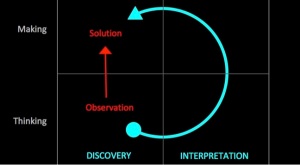We are getting better. I need to remind myself of that. I need to take a deep breath, and remind myself that we have less classical IT thinking in our organization today than yesterday, and much less yesterday than two years ago.
So what the heck is “classical IT thinking?” Essentially, it is when all or part of the IT group make decisions that protects or optimizes systems instead of the people who are using the system/service.
Student satisfaction is down, but take heart, portal usage is up!
When I arrived at Armstrong, they were in the midst of implementing a new portal. This new portal would be a one stop shop for all of our students’ needs. Sounds great, I’m on board.
However, to ensure that students would go to the portal, the only way students could check their email (we are a Google campus) was to log in to the portal. STUDENTS COULD NOT CHECK THEIR EMAIL WITH THEIR SMART PHONES. Forgive me for shouting, but c’mon, people, c’mon. First, we know that many students are abandoning email in favor of texting, and we know that they carry phones everywhere. And we want them to check their email for class information and general campus information.
Being new and given that I prefer to influence rather than mandate wherever possible, I began a Socratic process of working with the implementation team on the rationale behind this. Quickly, people realized that this wasn’t in the best interests of our students or Armstrong. The initial rationale was that we wanted the system to be successful, and this came slightly behind the success of the student. Classical IT Thinking.
But we might run out…
Before we begin, and I start scaring you, let me give you the ending: it all worked out.
We rolled out a new wireless system for our campus and increased coverage to our gorgeous green spaces and athletic fields, increased ability to handle growing device density (i.e., people connecting their iPhones, iPads, and laptops all at once), and save 30% on maintenance costs to boot!
Almost a win. So close…
Apparently, we were worried about running out of IP addresses, so we had the students have to log back in to the network. Every. Twenty. Minutes. Now, people are used to the home or Starbucks experience, where you log in and then you are good to go. We look fairly silly by not trying to duplicate this experience.
The students all perceived this as a service outage, not a normal part of wireless experience. I went on a “house calls” visit to residence halls recently, and students were up beat and happy. When I asked about wireless, their faces fell, and I began to hear the frustration.
What scarcity or resource over-consumption were we protecting against? We have a full class A range, so we have over 16 million addresses available. Let’s assume that every faculty, staff, and student has 5 devices at the peak of our enrollment and staffing levels. This would be about 45,000 ip addresses taken. Okay, lets add in a generous allowance for sensor building controls, and guests, etc. I’ll just round up to 100k. Wait, for capacity planning sake, I’ll assume that in the next three years we will match Arizona State’s 60k students with the fac/staff/buildings increasing in similar ratios. Now we are up to about 500,000 IP addresses needed.
Now I’m not a networking whiz, but some rough calculations tell me that it may be unnecessary to degrade the student wireless experience so we can keep (with grandiose plans) 15.5 million IP numbers on reserve. (Yes, I know that there are subnets and networking complexities that reduce that number; however, the main point remains that we were providing a disservice to our students over a fictional scarcity.)
Breaking the Cycle
The first step is not to blame or shame the people involved in classical IT thinking. Somehow this was engrained in their careers early on and perpetuated by the culture within IT and the institution. This is not a time for thunderous finger pointing, where people get defensive and close up, but a time where we can permanently change culture by being tough on the problem not on the people.
My first master’s was in organizational change, so we tackled this issue from that perspective rather than a technology perspective. Why was this mindset in place, and what mindset/culture did we want to be here instead?
Many IT organizations have grown up embedded under various units and have been relegated to a cost center status. IT is expensive, and it is precisely because it is so expensive that the IT leadership (not just the CIO) needs to be plugged into the what’s and why’s of campus. The IT staff thought their job was to implement the portal and have everyone use it and to ensure that the IP ranges were in no danger of being exhausted. There was little to no context of “why?” How does this affect the student experience? Does this have an impact on enrollment or retention?
What did we do?
1. Connect people to the mission of the university, which will put the IT part in context.
One of my primary goals in my first six months was to quiz my direct reports on the university’s strategic goals. What are the enrollment figures? Retention? How can IT help support all of these things? Once we began a conversation that tied them into the real reason we are here, many of the classical IT thinking traps went away. We began to have discussions about the on-boarding process for students, faculty, and staff. We can partner with HR to make the experience of becoming a Pirate (we’re the Pirates, by the way) to be a positive one. Hear that? We can influence campus culture and impact people’s first impression of the campus with the way we design, implement, and support services. That’s pretty powerful, and it engages people.
In all-staff meetings, I gave away Starbucks or iTunes gift cards to staff who knew what was going on in the university around them. We made it fun, or at least I had fun doing it, and the staff probably had some fun at my expense when I was being hokey doing it. Laughter is okay, and it can make the learning process more enjoyable (and make the learning stick better too!)
2. Continuous Improvement Approaches: Six Sigma and Design Thinking
I have seen and experienced organizations that care more about the process than the outcome, but a good continuous improvement program focuses on both.
To help with ensuring that we are managing processes, we have begun a lean six sigma program whereby all directors worked to earn their green belt and all staff will have a yellow belt by the end of 2014. We’re not likely to do the heavy statistics portion or spend the time to finely measure the before state, but knowing and thinking in terms of a value stream map or understanding forms of waste (defects, overproduction, inventory, over-processing, motion, transport/handling, and waiting) can help with re-engineering services.
However, the biggest impact that we’ve seen was an exercise in Design Thinking. I had some of my former colleagues from Miami University’s AIMS come down to give us a workshop. People generally enjoyed this much better than the lean six sigma approach (perhaps because there was no use of Minitab?). The design thinking approach starts with observation, empathy and understanding what the “customer” wants. This empathetic bond created outside of the transactional context is powerful. What do customers really want during the transactio n and afterwards? What elements can we design to make that happen? By analyzing the context around the service and transaction, you get to use creativity to develop solutions. Given the relationship nature a university has with its faculty, staff, and students, we do want to create a feeling that goes with our campus experience. We want our services to be efficient, yield good results, and also create a feeling of welcome for our students, faculty, and staff.
n and afterwards? What elements can we design to make that happen? By analyzing the context around the service and transaction, you get to use creativity to develop solutions. Given the relationship nature a university has with its faculty, staff, and students, we do want to create a feeling that goes with our campus experience. We want our services to be efficient, yield good results, and also create a feeling of welcome for our students, faculty, and staff.
By the way, for both six sigma and design thinking we invited staff from all over campus, and it was a great way for us to share with other service areas and develop relationships. Of particular value was that many from enrollment service areas went to both six sigma and design thinking, and we wound up collaborating to come up with some excellent improvements to our admissions and financial aid processes because of these engagements. And great relationships. Let me say that one more time: great relationships.
Wrapping it up
People want to be engaged and know their work has meaning, particularly in IT where something that is brand new and innovative may be old hat in 5 years. If we are on this cycle of churn, then helping to connect people to the institution’s mission and giving people tools will help with that engagement. And, it will help significantly reduce classical IT thinking.
Most importantly, it will help ensure that IT enables students, faculty, and staff to do their work with fewer frustrations!

